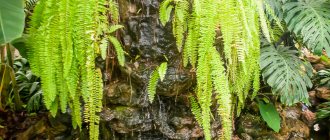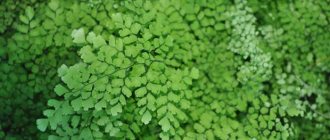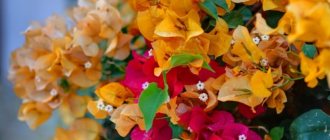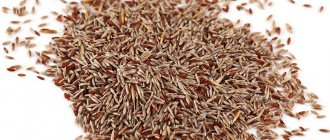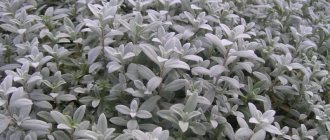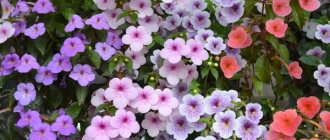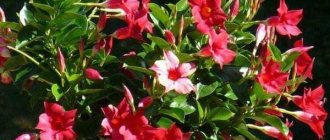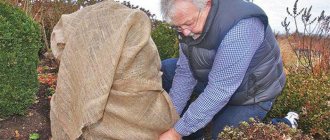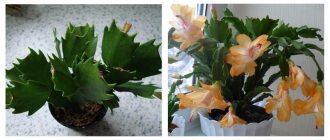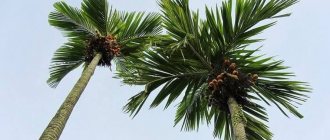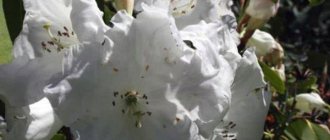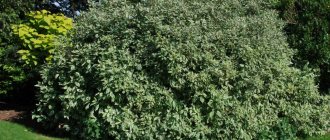Pellea is an elegant miniature indoor fern with bright ornamental foliage. The shiny, as if polished, and almost perfectly round leaves of the most common round-leaved variety in home culture form fronds that are not quite typical for the fern group. It is believed that growing this indoor flower is not so easy, and yet caring for pelley can hardly be called too complicated and burdensome. But it can confidently be considered one of the most charming representatives of the family for its unusual shape, compact size and spectacular “push-button” foliage.
General description with photo
Pellea is a genus of ferns from the family Synopteris. In the wild, it is found in tropical and subtropical forests of different continents - Africa, Central America, and the islands of New Zealand. Among related fern plants, pelley is distinguished by its miniature size and love for relatively dry growing conditions. It can be found in coastal areas and dry mountain regions. During periods of prolonged drought, the plant may lose all its foliage, but as soon as moisture appears, it quickly restores its lush vegetation.
The height of the pelley crown rarely exceeds 25-30 cm, and the length of its fronds is 30-40 cm. The plant does not have a pronounced dormant period, is an evergreen rhizomatous perennial and continues to grow all year round, but in the spring-summer period its development is more intense. Creeping roots are superficial. The formation of fronds occurs immediately from the root collar of the plant; there is no stem. The branches are soft, drooping, which is why the crop is often grown as a hanging plant, and in warm regions it can play the role of an effective ground cover.
The leaf segments are repeatedly pinnately divided on top and have a glossy sheen and are dark green. The underside of the leaf is rough and lighter; sporangia are located on it in a linear order, hidden behind a thin veil.
Types of pelley with photos
The genus includes about 80 varieties, most of which have been reclassified in recent years. Only a few species are suitable for cultivation at home.
Pellea rotundifolia
The most decorative and popular variety of crop, an absolute favorite in home gardening. Is of New Zealand origin. Forms a neat bush up to 30 cm high with a flattened shape. The rhizome is creeping, scaly, producing multiple root shoots if possible. The leaves are once pinnate, with segments up to 4 cm, almost perfectly round or elliptical in shape, each frond has up to 20 pairs. The leaf blades have a solid edge and a dark color on the outside, their surface is dazzlingly smooth and glossy. The frond cuttings have a scaly structure, which makes them look red-brown, which gives the fern a special decorative appearance.
One of the most famous varieties of the variety is “Rotundifolia”.
Pellea green
The first and main difference from the previous type is the elongated shape of the leaf segments and their pronounced relief. In addition, this variety is distinguished by its larger size. Thin shoots are painted in a dark chocolate tone, as is the edge of the leaves.
Pellea lancea
Absolutely smooth leaves without a relief pattern have a triangular elongated shape. The fronds are creeping, longer, their size reaches 60 cm.
Pellea naked
The shoots are colored dark brown, their length is standard for this genus (about 35 cm). The leaves have a regular oval-elongated shape, with a clearly visible central vein. This variety is particularly demanding of light, but is more resistant to cold than others.
Pellea dark purple
A variety whose appearance stands out from other representatives of the genus due to its highly elongated leaf segments, more similar to lanceolate leaves. The shoots are dark cherry-brown in color, the leaves are arranged alternately. The best place to grow this species is a window facing north.
Pellea ovoid
An elegant appearance with an unusual heart-shaped leaf shape for a plant, painted in a light olive green color. The shoots are green, slightly leafy, pubescent. The crown height can reach 40 cm. The plant loves bright, diffused color and is drought-resistant.
Pellea is beautifully dark
A variety of African origin. Forms a lush root rosette. A characteristic difference is the double or triple pinnate foliage on long fronds up to 60 cm. The leaves are long-petiolate, of an unusual triangular-asymmetrical shape; the petioles are dark red.
Home care
If you read the forums of indoor fern lovers, many gardeners classify pelley as a plant with a complex character. If handled incorrectly, the bush can quickly fly around, losing all its decorative effect. However, it has good recovery ability. The most important points of pelley care are lighting and moisture consumption.
Lighting requirements
This plant requires a lot of light, but it must be diffused. It is not recommended to grow this fern on a windowsill (with the exception of a north window), but even in the depths of the room the crown will lose its lushness and attractiveness. Poor lighting makes the color of the foliage faded and the growth of shoots slow. The ideal place to place a flower pot would be by a window behind a curtain or on a windowsill, the window of which is protected from the sun from the street by the crown of a thick tree.
Watering mode, air humidity
Growing not only in dry, including mountainous areas, but also in coastal zones near water has endowed this type of fern with specific requirements regarding irrigation. It is advisable to moisten the soil evenly, but in small portions; the water must be soft; salinization of the soil is unacceptable. The second requirement for water is its temperature; in no case should it be lower than the air temperature in the room. Between waterings, the soil should dry out only in the very top layer. Overmoistening is completely unacceptable; the delicate roots of the pelley can quickly begin to rot. The plant is drought-resistant, however, if there is a lack of moisture, its decorative appearance can be greatly affected, the foliage can thin out, and unsightly voids will remain in place of dried and fallen segments.
When watering the pelley, do not allow water to get on its leaves!
Temperature
During intensive vegetative development in the spring-summer period, the plant can be damaged by both sudden cooling and too hot conditions, which can become another reason for shedding foliage in order to save moisture. If the room temperature is above +25C, it is necessary to provide the pelley with more frequent, but not too abundant watering. With the onset of late autumn, it is advisable to place the pot with the plant in a cool place; a comfortable temperature for it will be +16...+18C. If the room is hot, you need to take measures to humidify the air near the fern, otherwise the tips of the leaves will begin to dry out.
Feeding
The fertilizer regime is set to a standard one - complex mineral compounds are applied in spring and summer; in the second half of the year, no fertilizing is necessary, as this may provoke a shift in the life cycle. The frequency of feeding is once every 2-4 weeks.
Earth mixture
Pellea grows well on loose, nutritious humus soils with high-quality aeration parameters. If it is not possible to buy a ready-made composition for fern crops, you can mix leaf soil, high peat and sand in equal proportions. Arranging a drainage layer at the bottom of the pot is necessary.
To make the soil for planting pellets loose and breathable, it is recommended to add a little charcoal to it.
Transfer
An adult pelley plant rarely needs replanting due to its compact size. But, since the root system is superficial, it periodically becomes cramped in the old pot. The increase in the width of the container with each new transplant should be about 2 cm in diameter. Transplantation is carried out by transshipment with the maximum possible preservation of the old earthen coma - damage to the roots of the pelley is painful. Only after the bush is placed together with a lump of earth in a new pot, the voids are carefully filled with new soil.
In those years when replanting is not carried out, it is recommended to very carefully remove the top layer of soil, without touching the roots, and replace it with fresh soil.
Trimming
The pelley tolerates molding quite calmly, so you can regularly trim shoots that grow sloppily, are diseased, or have lost some of their foliage and decorativeness. An old specimen that has become unsightly can undergo radical anti-aging pruning by briefly removing all growing shoots.
Plant care
At home, pelley is undemanding in care. She prefers rooms with diffused, bright light. In the summer, when the cold snaps at night stop, you can take the pots to a shady garden. In winter, artificial lighting may be needed on the north window to provide 12 hours of daylight. The optimal temperature is +20…+22°C. For winter, it is recommended to choose cooler places (+14…+16°C). Extreme heat causes leaves to dry out and fall off.
Water the plant with small portions of soft water. The procedure is carried out frequently so that only the upper part of the soil has time to dry. Water for irrigation should be warm. It is not allowed to get on the leaves. Stagnation of moisture is also unacceptable, otherwise the roots may rot.
From April to September, mineral fertilizers are added to the irrigation water monthly. It is recommended to use a complex composition for indoor deciduous plants.
Pelley does not need too humid air. An indicator of 50% will be quite enough. In a damp and cool room, this fern may suffer from rotting. Spraying and additional moistening are necessary only for those specimens that winter near hot radiators.
The pelley is transplanted every 1-2 years. Pots are chosen a few centimeters larger than the previous ones, but not too large. The container should not be too deep. The roots are carefully freed from the earthen coma. The bottom is lined with a layer of expanded clay or brick chips as drainage.
The soil for planting pelley must have a neutral or slightly alkaline reaction. You can buy a ready-made substrate for ferns in the store with the addition of lime. During the week after transplantation, the pelley needs special care. The plant is placed in a warm, shaded place and watered rarely.
Pellea is disease resistant and does not suffer from parasite attacks. With proper care, it will delight you with lush green mass for a long time. Pelleia fern does not require regular pruning and maintains an attractive crown for many years.
Growing problems, pests
Of the pests, thrips, scale insects, and aphids most annoy the pellee. They should be dealt with using standard methods using insecticides. Among the diseases, you should be wary of nematode infection. A signal that the bush has become ill with this disease should be yellowing and drying of the leaves. It is very difficult to save an affected specimen; it is better to destroy it to avoid damage to other plants. Prevention against this disease can be done by using warm and settled, non-chlorinated water.
If the foliage curls and the fronds droop, the plant is most likely in a stuffy, rarely ventilated room.
Diseases and pests
The main problems and difficulties encountered when breeding pelleys and their causes:
- Pellea leaves turn yellow - the soil is waterlogged. It is necessary to reduce watering.
- Pelley withers - the soil is too wet at a low temperature. The earth ball does not have time to dry out between waterings.
- The tips of the pelley leaves turn yellow and dry out - the air is too dry. You need to spray the plant or move it to a more humid room. For example, to the kitchen. Leaves may wrinkle and fall off due to dry soil or too high ambient temperatures.
- The leaves of the pelley turn yellow, turn pale, their edges curl - the lighting is too bright. It needs to be shaded from direct sun or moved to another window. Bright light can cause sunburn of the leaves, causing yellow spots to appear on them, which subsequently turn brown.
- The leaves of the pelley darken, the plant stretches out - there is not enough lighting.
Among the pests, pelley is affected by spider mites, mealybugs, scale insects and aphids.
Pellea propagation
The easiest way to propagate is to divide the bush when replanting. The bush, together with the rhizome, is divided into several parts (it is best to tear it apart by hand), after which the divisions, according to the general rules, are transplanted into separate containers. After this, they require special care and temporary shading. At first, they can be covered with a bag or plastic container for better rooting, but do not allow them to overheat and overheat.
You can divide a pelley bush only if it has grown large enough and has expanded greatly.
Growing by spores
The method is long and does not guarantee the preservation of uterine varietal characteristics, but is acceptable for basic varieties. Spores are poured onto the surface of a nutrient soil mixture with a predominance of peat and sand and covered with glass (film, plastic). The container is ventilated daily, lightly moistening the soil, removing condensation that has formed during the day from the film or glass. The planting container should be in a shaded place until germination; you will have to wait 1.5-2 months for them. After this, the shelter is removed. And the container is transferred to a well-lit place, but not in the open sun. Lack of light at this stage can cause the shoots to stretch, which will later be very difficult to correct. Planting in separate containers is carried out as several pairs of leaves form.
Description
Home pelley often grows up to 0.25 m. The length of the leaves can reach up to 30 cm, and their width up to 1.3 cm. Its most active growth occurs in spring and summer.
Plant care
You definitely need to know about proper care for indoor pelley flowers at home.
Illumination
Pelleia fern requires consistently high and bright, but diffused light. In poor lighting, the leaves turn pale and die, and the development of the bush becomes slower. If possible, it is worth creating a backlight for the fern; for this you can install a special lamp.
Temperature
In summer, during the most active growth, you need to ensure that the room temperature is about 23 C. In the cold season, it is recommended to move the fern to a cool place (not lower than 16 C). The bush must be frequently moistened with a sprayer, otherwise its foliage begins to deteriorate.
Watering and air humidity
You should constantly moisten the soil mixture in the pot, while ensuring that moisture does not stagnate in the rhizome of the plant, as this can cause the appearance and development of rot.
In spring and summer, the bush is watered immediately after the surface of the substrate in the container dries to a depth of about 10 mm. On average, watering should be done 3 times a week. Pruning and replanting
For proper transplantation, the next flower pot should be selected in a size that is 20 mm higher and wider than the old one. It is recommended to replant the plant using the transshipment method, and it is worth trying to preserve the lump of soil from the pot. The fact is that pelley transplantation is quite painful.
The fern is replanted only when absolutely necessary, when the rhizome becomes very crowded in the pot. Once every 2 or 3 years, be sure to add fresh soil mixture to the pot, while carefully removing the old substrate to half the container.
During transplantation, inspect the bush; if it has grown greatly, then divide it into parts. The cuttings are planted in separate pots.
Trim the pelley regularly. This is necessary to ensure that the shape of the bush is not spreading, as well as to get rid of dried and old stems and leaf plates.
Reproduction methods
Division of this plant
Pelley can be propagated by division, provided that the bush is very large and very overgrown. A couple of stems need to be separated from the very central part of the bush; they must have a well-developed and strong rhizome. Only after this are the cuttings planted in separate pots and filled with soil, which is used for replanting adult shrubs.
In order for the cuttings to take root successfully, it is recommended to cover them on top with a bag or a plastic bottle with the neck cut off. During the required time, when the cuttings take root, they should be kept warm, but not too hot (about 23°C).
Growing pelley from spores
You need to fill the pot with soil and level it, then you need to sow the spores. Then you need to cover the crops with either glass or film.
As soon as the very first seedling plants appear, the pot or other container with them should be moved to a place well illuminated by sunlight. If this is not done, then the new plants will not grow and stretch as actively.
And immediately after the formation of several pairs of true leaf blades, they should be transplanted into individual, but not very large pots; it is necessary to keep a lump of soil on the roots and replant them individually with it, as this will avoid stress on the plant.
Diseases and pests
The most common parasites that appear on pelleys are scale insects, as well as thrips and aphids, and the disease inherent in it is a nematode. To remove and protect the plant from parasitic insects, the bush should be sprayed with a mixture of an insecticidal preparation.
And for the purpose of preventive work against the appearance of parasites, the fern should be regularly sprayed with water from a spray bottle.
If the foliage begins to turn yellow and dry out, then this is a clear sign that the bush has become infected with a nematode. Sometimes the reason for this lies in the fact that the grower waters the plant only with very cool water, or there is too much chlorine in it.
Curling and drooping of the foliage may be due to the fact that the room where the plant is present is not often ventilated.
